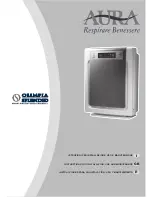
IM 882 / Page 13 of 36
Factory
Supplied
Holes (2)
Cooling
Chassis
Damper
Actuator
Hydronic Heat Section
Wall Sleeve
Figure 16. Installing the Cooling Chassis and Hydronic
Heat Section
6. Do not lubricate motors before start-up. Motors are
factory lubricated. Consult “Scheduled Maintenance”
section on page 31 for lubrication instructions.
7. Place Tinnerman clips from bag onto wall sleeve.
Clips and mounting screws are enclosed in a bag
attached to the top of the condenser coil cover.
8. If louver has not been previously installed, connect
to wall sleeve as described above.
9. If louver is supplied by others, as illustrated in
Figure 12, page 10, be sure to install foam type
gaskets on all sides of the condenser coil to prevent
recirculation or bypass of condenser air.
10. Slide chassis into wall sleeve until firmly seated
against weather seals of wall sleeve.
Caution:
Do
not push on coil surface or control box cover. Make
sure the compressor tubing does not catch when
inserting chassis.
11. Secure chassis to wall sleeve with four (4) sheet
metal screws packaged with the Tinnerman clips.
12. Plug electrical cord into receptacle. Excess cord
should be coiled up neatly and stored in the
conditioner.
13. Set the manual damper operator in open or closed
position as desired. On units equipped with the
optional electric fresh air damper, set for “AU”
or "CL" in the Configuration Mode. In “AU,” the
damper is open whenever the indoor fan motor is
running (AU is Auto and CL is Closed).
14. Set the indoor fan mode for off cycle on the PC
board for the off cycle selection of 10, 20, 30
minutes or 1 hour off cycle time. The fan will operate
for 2 minutes and shut down for the selected off
cycle period. For continuous fan operation, the fan
mode selection on the touchpad or remote thermostat
must be set to continuous or on. When the room
thermostat is in the cycle or auto mode, it will cycle
the indoor fan when there is a call for heating or
cooling. See page 28 for jumper placement details.
15. Set the temperature limiting feature to the desired
range of thermostat operations. As shipped, the
range is 60°F to 85°F.
16. Replace the air filter and front panel.
17. Connect the low voltage valve wires with the
Molex connection to the valve.
Heat Section Installation
The heat section is designed to be “snapped” into the top
of the wall sleeve (Figure 16). There are four square holes
provided in the wall sleeve, two on each side, for coil at-
tachment. Assembly the heat section to the wall sleeve as
follows:
1. Unpack the heat section and inspect for any shipping
damage. Report any damage found to the carrier.
2. Check the heat section against the plans to make certain
the coil supplied has the connections match the specifica-
tions.
3. Firmly attach the heat section to the wall sleeve by lining
up the heat section hooks with the square holes supplied
in the wall sleeve. Snap the heat section in place by
exerting pressure downward.
4. The valve is always connected to the supply side of
the coil. There are seven possible coil arrangements
available. Each is shown on the next page. Select the
illustration below that matches the coil supplied and pipe
it according to the illustration. Install valve and other
accessories including air vents, steam traps, stop balance
valves, etc., as specified by the design engineer.
5. For valve installed on right side of the unit, make elec-
trical connection to matching cap extending from the
control box. For left side valve, make electrical connec-
tion to cap mounted to left side of chassis.
Note:
When the heating medium is steam, the supply
connection should be attached to the uppermost tube
and the return to the lower tube. The coil is pitched in the
casing to allow drainage of condensate.
When the heating medium is hot water, the supply
connection should be made to the lowermost tube and
the return to the uppermost tube. Hot water coils
should be “flooded” to minimize air entrapment.














































